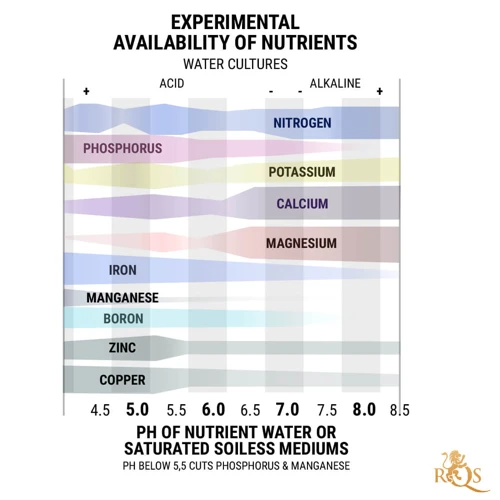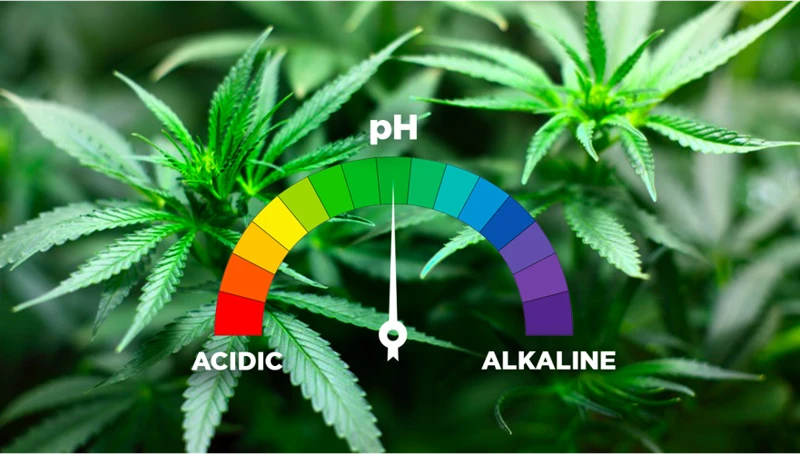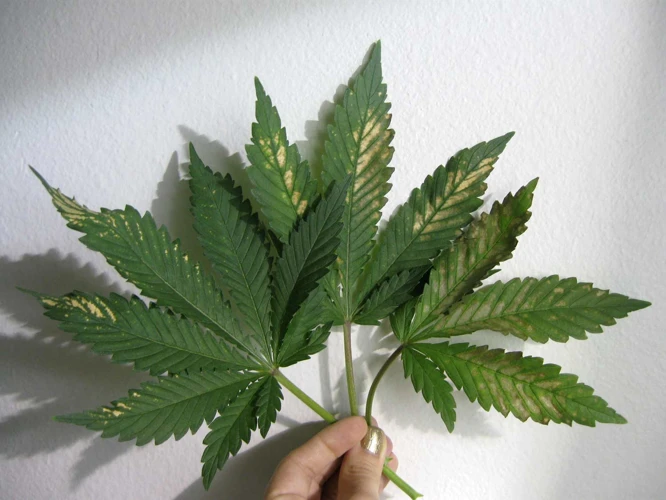
Why Is pH Important in Watering Cannabis Plants?
As a cannabis grower, you may find yourself perplexed by the various factors that can influence the growth and yield of your plants. One of these crucial factors is the pH level of the water you use for watering your plants. pH, an abbreviation for “potential of hydrogen,” is a measurement of the acidity or alkalinity of a substance. It may seem like a small detail, but the pH level can have a significant impact on the health and growth of cannabis plants. In this article, we will explore the importance of pH in watering cannabis plants, how to test and adjust pH levels, and common problems that growers may encounter.
What is pH?
Contents
Understanding the concept of pH can be perplexing, but it is crucial in growing healthy cannabis plants. pH stands for “potential of hydrogen” and refers to the concentration of hydrogen ions in a solution. This measurement is significant because plants can only absorb nutrients within a specific pH range, and their ability to absorb water and nutrients depends on the quality of the soil and water. In this section, we’ll delve deeper into the meaning of pH and its importance in growing cannabis plants.
pH Scale
The pH scale is a measure of the acidity or alkalinity of a solution. It is based on the concentration of hydrogen ions (H+) in a solution. The pH scale ranges from 0 to 14, with 7 being neutral. Solutions with a pH below 7 are considered acidic and those above 7 are considered alkaline (basic).
Acidic Solutions
Neutral Solutions
Alkaline Solutions
It is important to have an understanding of the pH scale when growing cannabis because the pH of the soil or water can have a significant impact on the plant’s health and ability to absorb nutrients.
Importance of pH in Growing Cannabis
As any experienced grower will tell you, maintaining the correct pH level during the growth cycle of cannabis plants is essential for producing high-quality buds. Unfortunately, many novice growers are unaware of the importance of pH and how different levels can impact their plants’ growth and overall health. In this section of the article, we will discuss the critical role that pH plays in cannabis cultivation and how it affects nutrient absorption, soil microbes, and water quality. By understanding these concepts, growers can ensure that their plants are getting the right nutrients and growing in the healthiest environment possible.
Effect on Nutrient Absorption
Maintaining the proper pH level is crucial for the cannabis plant’s nutrient absorption. The plant will grow best in a pH range of 6.0 to 7.0 for soil and 5.5 to 6.5 for hydroponic setups. When the pH level is not within this range, the plant may unable to properly absorb the required nutrients.
The table below shows the availability of nutrients at various pH levels.
| pH Level | Nutrient Availability |
|---|---|
| 3.5 | Aluminum (toxic) and Manganese (toxic) |
| 4.0 | Iron (toxic), Manganese (toxic), Zinc (toxic), Copper (toxic), Boron (toxic) |
| 4.5 | Iron, Manganese, Zinc, Copper, Boron |
| 5.0 | Iron, Manganese, Zinc, Copper, Boron |
| 5.5 | Iron, Manganese, Zinc, Copper, Boron |
| 6.0 (optimal range for soil) | Iron, Manganese, Zinc, Copper, Boron, Calcium, Magnesium, Molybdenum, Sulfur |
| 6.5 | Iron, Manganese, Zinc, Copper, Boron, Calcium, Magnesium, Molybdenum, Sulfur |
| 7.0 (optimal range for hydroponics) | Iron, Manganese, Zinc, Copper, Boron, Calcium, Magnesium, Molybdenum, Sulfur |
| 7.5 | Iron, Manganese, Zinc, Copper, Boron, Calcium |
| 8.0 | Iron (toxic), Manganese, Zinc, Copper (toxic), Boron (toxic), Calcium (toxic) |
| 9.0 | Iron (toxic) and Manganese (toxic) |
| 10.0 | Iron (toxic) and Manganese (toxic) |
As we can see from the table, the optimal pH range for soil is between 6.0 to 6.5, while the optimal pH range for hydroponics is between 5.5 to 6.5. When the pH level is below or above this range, the plant will not be able to absorb certain micronutrients, such as iron, which can result in a nutrient deficiency.
The pH level has a significant impact on nutrient absorption and the availability of micronutrients in the soil or hydroponic solution. It is important to maintain the optimal pH level to ensure the plant receives the necessary nutrients for healthy growth.
Effect on Soil Microbes
The pH level of soil significantly impacts the soil microbes that live within it. The soil environment is teeming with billions of microorganisms such as bacteria, fungi, protozoa, and nematodes. These tiny creatures play a crucial role in the growth and development of Cannabis plants as they break down organic matter and make nutrients available for uptake by plant roots.
High pH
Soil with a high pH (greater than 7) has an alkaline soil environment that makes it difficult for soil microbes to survive. When the pH level is too high, soil microbes become less active and less efficient in breaking down organic matter, which results in nutrient deficiencies for the Cannabis plant. A higher pH level also makes harmful soil pathogens, like Fusarium and Phytophthora, more prevalent, leading to the likelihood of disease outbreaks and root rot.
Low pH
A low pH (less than 5.5) indicates acidic soil, which can also negatively affect the microbial population in soil. Acidic conditions can lead to an increase in the prevalence of harmful microbes, such as bacteria that cause damping off disease. At the same time, acidic soils also can result in insufficient enzyme production and cause the slow release of Nitrogen, Magnesium, and Calcium.
The ideal pH range for soil is between 6.0 and 7.0, which allows optimal microbial activity in the soil. Adjusting the pH to this range can lead to a healthy soil environment, where microbes and plants can thrive together.
Maintaining an appropriate pH level in the soil is imperative for the optimal growth of Cannabis plants. The use of pH meters and soil testers can be helpful tools to ensure the pH remains in an appropriate range. By monitoring and regulating the pH levels of the soil, growers can ensure that the beneficial microbial populations in the soil, and the Cannabis plants growing in it, will be healthy and strong.
Effect on Water Quality
The pH level of water can have a significant impact on the quality of water used for growing cannabis plants. A pH level that is too high or low can negatively affect the plant’s ability to absorb nutrients properly. It can also affect the pH level of the soil, which can have an impact on the growth of soil microbes. The following are some of the effects of pH on water quality:
- Corrosion of equipment: Water with a pH level that is too low can be acidic, which can lead to the corrosion of equipment. This can be a problem for hydroponic systems, where equipment such as pumps and piping can be damaged by low pH water.
- Mineral solubility: The solubility of minerals in water can be affected by the pH level. Water with a high pH can cause minerals such as calcium and magnesium to become less soluble, which can lead to nutrient deficiencies in plants.
- Algae growth: Algae growth can be encouraged by water with a high pH level. This can be problematic for hydroponic systems, where algae can clog pumps and piping, leading to reduced water flow.
- Bacterial growth: Bacterial growth can also be affected by the pH level of water. Water with a high pH can encourage the growth of certain bacteria, which can cause root rot or other plant diseases.
- Chlorine effectiveness: Chlorine is commonly used to disinfect water, and its effectiveness can be affected by the pH level. Water that is too acidic or alkaline can reduce the effectiveness of chlorine, leaving the water at risk for contamination.
It is important to maintain the proper pH level of water used for watering cannabis plants. Testing the pH level and adjusting it as necessary can help to ensure that the water quality is optimal for plant growth.
Testing pH of Water
One of the most important factors in growing healthy cannabis plants is maintaining the proper pH level of the water used for irrigation. It’s crucial to understand what pH is and why it matters, as well as how and when to test the pH level of your water. Testing the water’s pH level can be done using various methods, and knowing how to adjust it properly can help ensure optimal nutrient absorption and prevent potential problems. Let’s delve into the details of testing pH levels in water for cannabis plants.
Methods of Testing pH
There are different methods for testing the pH of water for your cannabis plants. Here are some of the most common methods:
- pH test strips: These are paper strips coated with pH-responsive chemicals. You dip the strip into the water, wait a few seconds, and then compare the color of the strip to a color chart to determine the pH.
- pH drops: These are liquid indicators that change color in response to pH. You add a few drops of the indicator to the water, wait a few seconds, and then compare the color to a chart.
- Digital pH meters: These are devices that measure the pH electronically. You insert the probe into the water, wait a few seconds, and the digital display shows the pH.
Each method has its pros and cons. pH test strips and drops are affordable and easy to use, but they may not be as accurate as digital pH meters. Digital pH meters are very accurate, but they can be more expensive and require calibration and maintenance.
Whichever method you choose, make sure to follow the manufacturer’s instructions to get accurate readings of your water’s pH level.
When to Test pH
Testing the pH of water is an essential part of ensuring the health and growth of your cannabis plants. Here are some recommendations on when to test pH:
1. Before watering: Always test the pH of the water you are going to use before watering your plants. This allows you to make any necessary adjustments to the water pH before it even reaches your plants.
2. After adding nutrients: When adding nutrients to your water, the pH level can fluctuate. Be sure to test the pH level after adding nutrients and adjust accordingly.
3. When you notice any problems: If you notice any signs of nutrient deficiencies, such as yellowing leaves or stunted growth, it may be due to an incorrect pH level. Test the pH of the soil and water to determine if this is the problem.
4. Periodically throughout the grow cycle: pH levels can change over time. It is important to test the pH periodically throughout the grow cycle, especially if you are using soil, to ensure that the pH remains within the appropriate range for cannabis growth.
5. In hydroponic systems: In hydroponic systems, pH can fluctuate more rapidly due to the absence of soil. It is important to test the pH of the nutrient solution often to maintain a stable pH level.
Remember, keeping pH levels properly adjusted is crucial for healthy cannabis growth. Testing the pH at regular intervals will help you stay on top of any issues and take corrective action before it’s too late.
Adjusting pH of Water
One of the most crucial steps in growing healthy cannabis plants is ensuring the pH level of the water used for irrigation is appropriate. If the pH level is too high or too low, the plants may not absorb the essential nutrients required for strong growth. Additionally, unbalanced pH levels can also affect the soil’s nutrient uptake and cause issues in hydroponic systems. In this section of the article, we will delve into the methods and techniques of adjusting water pH levels to maintain optimal growing conditions for your cannabis plants.
pH Up and pH Down
When water pH levels are not optimal for growing cannabis, pH adjusters can be used to raise or lower the pH to the desired range. The two most commonly used pH adjusters are pH Up and pH Down. pH Up is typically made from a solution of potassium hydroxide or potassium carbonate, while pH Down is made from citric acid or phosphoric acid.
| pH Up | pH Down |
|---|---|
| Raises pH levels. | Lowers pH levels. |
| Made from a solution of potassium hydroxide or potassium carbonate. | Made from citric acid or phosphoric acid. |
| Should be added in small amounts and mixed well before testing pH again. | Should be added in small amounts and mixed well before testing pH again. |
It is important to note that adding too much pH Up or pH Down can drastically change the pH levels of the water, potentially harming the cannabis plants. It is best to add these adjusters in small amounts (a few drops at a time) and mix well before testing the pH levels again. This process should be repeated until the desired pH range (usually between 6.0 and 7.0 for soil, and 5.5 and 6.5 for hydroponics) is reached.
When working with pH adjusters, it is essential to wear gloves and protective eyewear, as these chemicals can be caustic and harmful. Additionally, pH adjusters should be stored in a cool, dry, and dark place, away from children and pets.
How Much to Adjust pH
When it comes to adjusting the pH of your water for your cannabis plants, it’s important to do so carefully and accurately. Over-adjusting can be just as detrimental as not adjusting enough. The goal is to reach a pH level that is optimal for nutrient absorption and soil microbial activity, without causing harm to the plant.
To determine how much to adjust the pH, you first need to test the pH level of your water. Once you’ve determined the current pH level, you can use the following table as a guide for adjusting the pH:
| Current pH level | Amount to adjust |
|---|---|
| 7.0 or higher | Add pH down until the desired pH level is reached |
| 6.5-6.9 | Add a small amount of pH down |
| 6.0-6.4 | Add a very small amount of pH down |
| 5.5-5.9 | Don’t adjust the pH |
| 5.0-5.4 | Add a very small amount of pH up |
| 4.5-4.9 | Add a small amount of pH up |
| 4.0-4.4 | Add pH up until the desired pH level is reached |
It’s important to note that this table is a guide and not a strict rule. You should always adjust the pH slowly and test it frequently until you reach the desired level. This will help prevent over-adjusting and give your plant the best chance for success. And remember, consistency is key when it comes to pH levels, so make sure to test and adjust regularly.
Using pH in Hydroponics
As we dive deeper into the world of growing cannabis, we come across the fascinating technique of hydroponics. Instead of soil, hydroponic systems use water to nourish the plants, which means that maintaining the pH of the water is critical to the success of the crop. In this section, we will explore how pH plays a crucial role in hydroponics and how to ensure that your plants thrive in this unique growing environment.
pH and Nutrient Solutions
Maintaining the proper pH level is critical when growing cannabis in a hydroponic system as it can significantly affect the absorption of nutrients by the plants. Different nutrients have their optimum pH range for absorption.
Nutrient | Optimum pH Range
— | —
Nitrogen (N) | 6.0 – 7.0
Phosphorus (P) | 6.2 – 7.2
Potassium (K) | 5.5 – 6.5
Calcium (Ca) | 6.0 – 7.0
Magnesium (Mg) | 6.0 – 7.0
Iron (Fe) | 5.0 – 6.0
Manganese (Mn) | 5.0 – 6.0
Zinc (Zn) | 5.5 – 7.0
If the pH level of the nutrient solution is too high or too low, the plants cannot absorb the nutrients correctly. For example, if the pH level is too high, some of the essential nutrients like iron, manganese, and zinc may start to precipitate out of the solution, making them unavailable to the plants. On the other hand, if the pH is too low, it may cause damage to the roots, as well as promoting the growth of harmful bacteria and fungi.
It is crucial to monitor the pH level of the nutrient solution regularly, at least once a day, and adjust it accordingly with pH up or pH down solutions to maintain the required pH range for each nutrient. It is also recommended to do a complete nutrient solution change every two weeks to avoid nutrient buildup and fluctuation in pH levels.
Common pH Problems
Maintaining the proper pH level is key in ensuring the healthy growth of cannabis plants. However, even with the best efforts, pH problems may arise which can negatively impact plant development. In this section, we will discuss some of the most common pH problems that cannabis growers may encounter and offer potential solutions for each. It is important to be vigilant and address these issues promptly in order to prevent any long-term damage to your plants.
High pH
When the pH of the soil or water is too high, it can cause several problems for cannabis plants. A pH level above 7.5 is considered high for cannabis cultivation. The following table summarizes the effects of High pH on cannabis plants:
| Effects of High pH | Symptoms |
|---|---|
| Poor Nutrient Uptake | Yellowing of leaves, stunted growth |
| Toxicity | Leaves may curl, turn brown, and drop off |
| Reduced Microbial Activity | Slowed nutrient cycling, poor soil structure, reduced resistance to pests and diseases |
When the pH is too high, essential nutrients become unavailable to the plant which can lead to nutrient deficiencies. At high pH levels, microorganisms in the soil are also impacted, leading to poor soil health and structure. This can make the plant vulnerable to pests and diseases. Additionally, high pH can also lead to nutrient toxicity, which may cause leaves to discolor and drop off, ultimately damaging the plant.
It is important to monitor and adjust pH levels to prevent cannabis plants from experiencing the negative effects of high pH.
Low pH
When the pH of water used for watering cannabis plants is too low, it means it is more acidic than the ideal range of 6 to 7.5. This can cause the roots to absorb too many nutrients, leading to root burn and plant damage. Low pH levels can affect soil microbes, making it harder for them to break down nutrients for the plant to absorb.
Here are some common signs that indicate low pH levels:
| Signs of Low pH | Description |
|---|---|
| Leaf yellowing | When leaves start to turn yellow, especially around the edges, it may be a sign that your plant is experiencing nutrient deficiencies due to low pH levels. |
| Slow growth | When cannabis plants are not able to absorb the necessary nutrients, growth will be slowed down. |
| Leaf curling | When leaves start to curl, it can indicate a nutrient deficiency caused by low pH levels. |
| Browning edges | Brown, crispy edges on leaves can indicate nutrient burn caused by a build-up of excess nutrients due to low pH levels. |
To correct low pH levels, pH up solution can be added to the water. This will increase the pH level and make the water less acidic. It is important to add the solution in small increments and test the pH level frequently to ensure it is within the desired range. Over-correcting the pH level can be just as damaging as having low pH levels, so it’s important to be cautious.
In hydroponic systems, low pH levels can also affect the nutrient solution. Nutrient uptake can be affected and lead to plant stress and stunted growth. Monitoring the pH level and adjusting as necessary is crucial for successful hydroponic cannabis cultivation.
Preventive Measures
Ensuring proper pH levels in watering cannabis plants is crucial for healthy growth and production. However, maintaining the desired pH levels can be challenging, especially for beginners. To avoid problems related to pH imbalance, growers can take some preventive measures to promote optimal pH levels.
Start with Quality Water: The quality of water used for watering cannabis plants can significantly affect the pH level. It is recommended to use filtered or distilled water to avoid any fluctuations in pH levels due to the presence of minerals and chemicals in tap water.
Adjust Soil Quality: The soil quality can also impact the pH level. The soil should be well-draining, loose, and aerated to avoid waterlogging and ensure proper pH balance. Adding organic matter like compost, manure, or peat moss can help maintain a balanced pH level.
Regular Soil Testing: Regular soil testing is crucial to prevent pH imbalance. Soil testing can help detect any variations in pH levels and allow growers to adjust the pH level accordingly.
Maintain Proper Nutrient and pH Levels: Maintaining proper nutrient and pH levels is essential for healthy growth and productivity of cannabis plants. Ensure you are using the right nutrients that are pH balanced. Follow a feeding schedule according to your plant’s growth stage, and pay attention to any signs of under or over-fertilization.
Monitor Watering Frequency: Over-watering or under-watering can significantly impact the pH level, leading to nutrient deficiencies or toxicities. Avoid over-watering by allowing the soil to dry out slightly before watering again. Under-watering can cause the pH level to rise, affecting the plant’s nutrient absorption ability.
By implementing these preventive measures, growers can ensure proper pH levels and maintain healthy cannabis plant growth. Regular monitoring and adjustments to pH levels can go a long way in promoting optimal growth and cannabis production.
Conclusion
After going through this detailed guide on understanding pH in watering cannabis plants, it is clear that pH plays a crucial role in the growth and health of your cannabis plants. Therefore, it is essential to keep a close eye on the pH levels of your water or nutrient solution.
We have learned that pH affects nutrient absorption, soil microbes, and water quality. Testing the pH level is crucial and should be done regularly, particularly in hydroponic systems where the pH level can fluctuate quickly.
If you notice the pH level is too high or low, you can adjust it using pH Up or pH Down solutions. The amount of adjustment required depends on the pH level and the volume of water or nutrient solution.
It is essential to note that maintaining the right pH level is not just a curative measure, but also a preventive measure against various problems that can arise due to pH imbalances.
In conclusion, monitoring and maintaining the pH level is crucial in growing healthy cannabis plants. With the right knowledge and tools, you can ensure that your plants get the best possible environment for growth and produce high-quality buds.
Frequently Asked Questions
1. Why is pH important in watering cannabis plants?
The pH level of water determines the availability of essential nutrients that cannabis plants need to grow healthy and strong.
2. What is the ideal pH range for watering cannabis plants?
The ideal pH range for watering cannabis plants is between 6.0 and 7.0.
3. How does pH affect nutrient absorption in cannabis plants?
pH affects nutrient absorption in cannabis plants as it determines the solubility and availability of minerals in the soil.
4. How can I test the pH level of the water I use for watering cannabis plants?
You can test the pH level of water by using pH test kits, pH strips, or digital pH meters.
5. When is the best time to test the pH level of the water?
The best time to test the pH level of water is before you start watering your cannabis plants.
6. How do I adjust the pH level of water for cannabis plants?
You can adjust the pH level of water by adding pH up or pH down solutions in small increments until you reach the desired pH level.
7. Can I use regular tap water for growing cannabis plants?
It depends on the pH level of your tap water. If it is within the ideal pH range, then you can use it. However, if it is too high or too low, you will need to adjust it. Tap water may contain minerals and chemicals that can harm your plants, so it is recommended to use filtered or distilled water when possible.
8. What problems can high pH levels cause in cannabis plants?
High pH levels can cause nutrient deficiencies, wilting, and yellowing of leaves in cannabis plants, as well as decrease the effectiveness of some pest control products.
9. What problems can low pH levels cause in cannabis plants?
Low pH levels can cause stunted growth, yellowing of leaves, and nutrient lockout in cannabis plants.
10. Can Hydroponics be used to avoid problems with pH levels?
Hydroponics can be used to avoid problems with pH levels, as the pH of the nutrient solution can be easily monitored and adjusted. However, hydroponics requires more advanced equipment and knowledge and may not be ideal for beginner growers.








